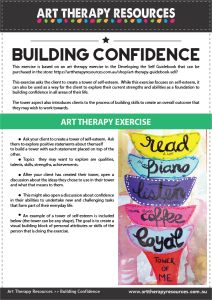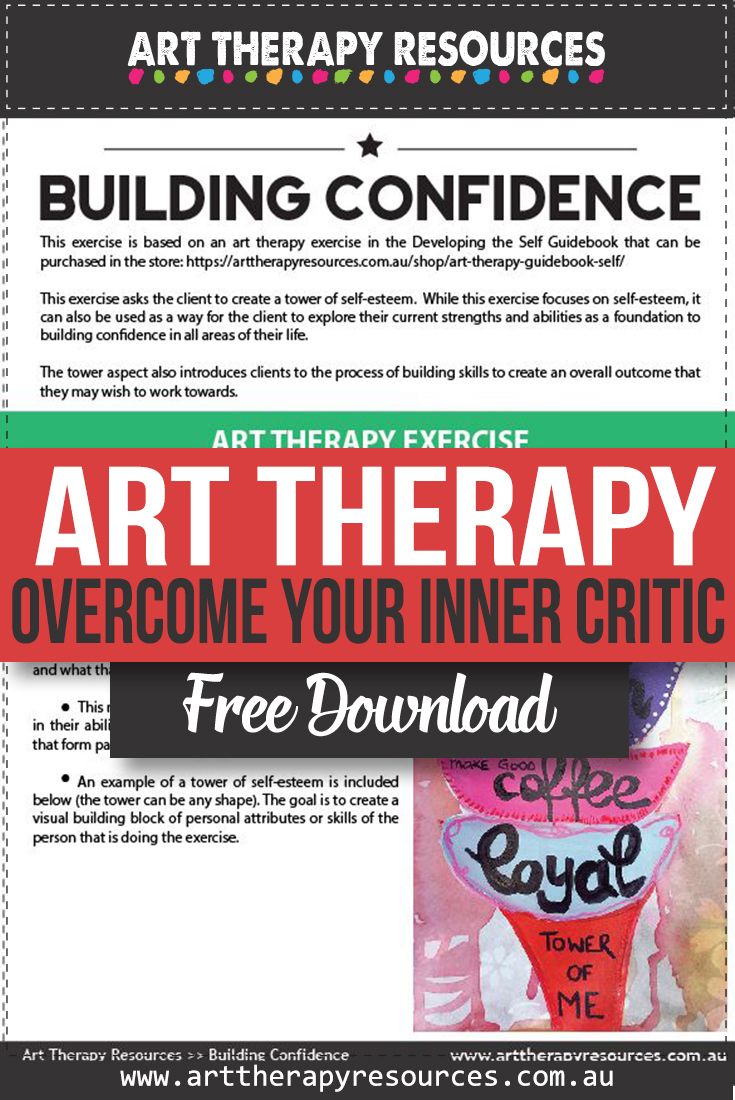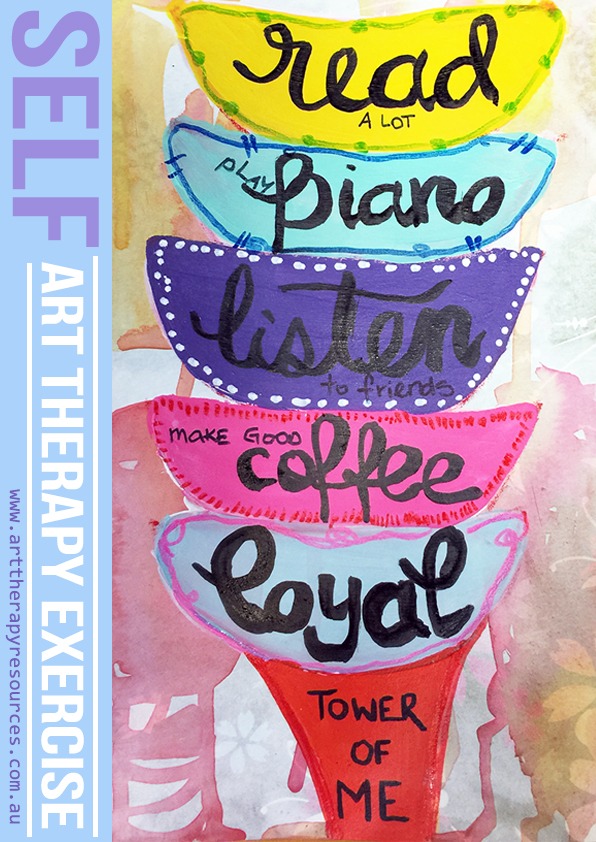THIS POST INCLUDES:
1. Introduction
2. Functions of Art Therapy
3. Using Art Therapy to Overcome Your Inner Critic
4. Common Art Therapy Techniques
5. Free Download Art Therapy Exercise
INTRODUCTION
In our daily lives, we often face an inner critic—an internal voice that constantly judges, criticizes, and undermines our self-worth. This inner critic can be a significant barrier to personal growth, self-expression, and overall well-being.
Art therapy offers a unique and creative approach to addressing your inner critic and nurturing self-acceptance. In this blog post, we will explore the transformative benefits of art therapy in overcoming your inner critic. Through a combination of artistic expression and therapeutic techniques, art therapy can empower you to cultivate self-compassion, embrace vulnerability, and rediscover the joy of creation.
Art therapy offers a powerful avenue for overcoming your inner critic and cultivating self-acceptance. Art therapy allows for self-expression, self-reflection, and personal growth. By engaging in the creative process, you can silence the judgments of your inner critic and tap into your innate creativity and resilience.
Through the creative process, you can tap into your innate creativity, silence self-doubt, and embark on a transformative journey of self-discovery. Remember, art therapy is not about artistic skill but about embracing vulnerability, self-acceptance, and the therapeutic benefits of the creative process.
FUNCTIONS OF ART THERAPY
Art therapy is a form of expressive therapy that uses the creative process of art-making to improve mental, emotional, and psychological well-being. It provides a safe and non-judgmental space for self-expression, allowing individuals to explore their thoughts, emotions, and experiences.
The power of art therapy lies in its ability to bypass the constraints of language and tap into the deeper realms of the subconscious. It provides a safe and supportive space for self-exploration, healing, and personal growth.
Below are some ways art therapy can help you overcome your inner critic:
1. Self-Exploration: Art therapy encourages self-reflection and introspection, enabling you to gain insight into your inner world and underlying emotions.
2. Silencing the Inner Critic: Engaging in the creative process of art-making can help quiet the relentless voice of your inner critic, providing a sense of freedom and liberation. By focusing on the creative process and letting go of judgment, you can create a space of self-acceptance and self-compassion.
3. Self-Expression: Art therapy provides a medium for self-expression when words may fall short. It allows you to communicate and process complex emotions, experiences, and narratives through the language of art.
4. Embracing Imperfection: Art therapy teaches you to embrace imperfections and let go of the need for perfection. It fosters a sense of acceptance and self-compassion.
5. Building Confidence: Engaging in art-making and witnessing your creative expression can boost self-confidence, fostering a positive self-image.
6. Emotional Release: Art therapy provides a healthy outlet for emotions. Through the act of creation, you can release pent-up feelings, reduce stress, and experience emotional catharsis.
7. Increasing Self-Awareness: Engaging in art therapy encourages self-reflection and introspection. It helps you gain deeper insights into your thoughts, emotions, and patterns of behavior, fostering self-awareness and personal growth.
8. Building Resilience: Art therapy promotes resilience by providing a means to navigate and overcome challenges. It cultivates problem-solving skills, encourages flexibility, and fosters a sense of empowerment.
USING ART THERAPY TO OVERCOME YOUR INNER CRITIC
Now that we understand the power of art therapy to help improve wellbeing, let’s explore techniques and strategies to utilize it effectively in silencing your inner critic and cultivating self-acceptance and self-expression.
1. Engage in Free Expression – Give yourself the freedom to create without judgment or expectations. Allow your artistic process to unfold naturally, without focusing on the end result. Embrace spontaneity, experiment with different materials, and let your intuition guide your art-making journey.
2. Practice Mindfulness – Engaging in art therapy with a mindful approach can help you stay present in the moment and connect with your inner self. Pay attention to the sensations, thoughts, and emotions that arise as you create. Mindfulness allows you to observe your inner critic without attaching to its judgments. Create a calm and focused environment, free from distractions. Pay attention to the sensations, colors, textures, and movements as you create. Be fully present in the moment, observing and accepting your thoughts and emotions without judgment.
3. Use Art Journaling – Art journaling combines writing and art-making, providing a powerful tool for self-expression and reflection. Create a dedicated journal where you can freely express your thoughts, feelings, and experiences through a combination of writing, drawing, collaging, and painting.
4. Explore Symbolism – Symbols have deep personal meanings that can transcend words. Explore the use of symbols in your art therapy practice to convey emotions or experiences that may be challenging to express directly. Let the symbols speak to you and trust your intuitive interpretation.
5. Embrace the Process, Not the Outcome – In art therapy, the focus is on the process rather than the final product. Release the attachment to the end result and embrace the journey of self-discovery and self-expression. Allow yourself to make mistakes and learn from them, valuing the lessons gained along the way.
COMMON ART THERAPY TECHNIQUES
1. Collage Therapy – Collage therapy is a powerful technique that involves creating collages using various materials, such as magazines, photographs, and found objects. It allows you to express yourself visually, combining different elements to create a cohesive representation of your inner thoughts and feelings. Collage therapy can help you explore your inner critic and challenge its messages through visual storytelling.
2. Expressive Drawing – Drawing is a versatile and accessible form of art therapy. Use drawing as a means to express your emotions, thoughts, and experiences. Allow yourself to draw freely without worrying about artistic skill or representation. Embrace imperfections and focus on the process rather than the end result.
3. Guided Visualization and Art – Combine the power of guided visualization with art-making. Close your eyes, take deep breaths, and visualize a peaceful and supportive environment. Then, open your eyes and translate your visualization onto paper or canvas using colors, shapes, and symbols. This exercise can help you tap into your inner wisdom and challenge the negative narratives of your inner critic.
4. Body Mapping – Body mapping involves tracing or drawing an outline of your body and filling it with colors, images, or words that represent your thoughts, emotions, and sensations. This technique allows you to explore the connection between your inner world and your physical presence. It can be particularly helpful in addressing body image issues and challenging negative self-perceptions.
5. Journaling with Art – Combine the benefits of art therapy with the practice of journaling. Use art materials alongside writing to express yourself fully. Create visual representations of your thoughts, feelings, and experiences, and then write about them in your journal. This combination of art and writing can provide a deeper level of self-reflection and insight.
6. Group Art Therapy – Participating in group art therapy can be an enriching experience. Engaging in art alongside others allows for shared support, validation, and inspiration. It creates a sense of belonging and community, and witnessing others’ creative processes can broaden your own perspectives and provide new insights into your inner critic.
7. Transformative Artwork – Create artwork that symbolizes your journey of overcoming your inner critic and embracing self-acceptance. Use symbolism and metaphor to visually represent your transformation. Display your artwork in a prominent place as a reminder of your resilience and growth.
8. Art Rituals – Incorporate art-making as a regular ritual in your life. Set aside dedicated time for creative expression and self-reflection. Establish a sacred space where you can immerse yourself in the artistic process without distractions. Treat art-making as a nurturing and meditative practice.
ART THERAPY EXERCISE
This exercise is based on an art therapy exercise in the Developing the Self Guidebook that can be purchased in the store.
This exercise asks the client to create a tower of self-esteem. While this exercise focuses on self-esteem, it can also be used as a way for the client to explore their current strengths and abilities as a foundation to building confidence in all areas of their life. The tower aspect also introduces clients to the process of building skills to create an overall outcome that they may wish to work towards.
ART THERAPY EXERCISE INSTRUCTIONS:
- Ask your client to create a tower of self-esteem. Ask them to explore positive statements about themself to build a tower of self-esteem with each statement placed on top of the other. Topics they may want to explore are qualities, talents, skills, strengths, achievements.
- The goal is to create a visual building block of the personal attributes or skills of the person that is doing the exercise.
- After your client has created their tower, open a discussion about the ideas they chose to use in their tower and what that means to them.
- This might also open a discussion about confidence in their abilities to undertake new and challenging tasks that form part of their everyday life.
An example of a tower of self-esteem is included below (the tower can be any shape).
FREE DOWNLOAD: Art Therapy Exercise
SIGN UP below to download the FREE Art Therapy Exercise. You can find more art therapy exercises like this in our guidebook – Developing The Self

BUILD YOUR ART THERAPY REFERENCE MATERIALS:
Pin this image to your Pinterest board.

SHARE KNOWLEDGE & PASS IT ON:
If you’ve enjoyed this post, please share it on Facebook, Twitter, Pinterest. Thank you!

